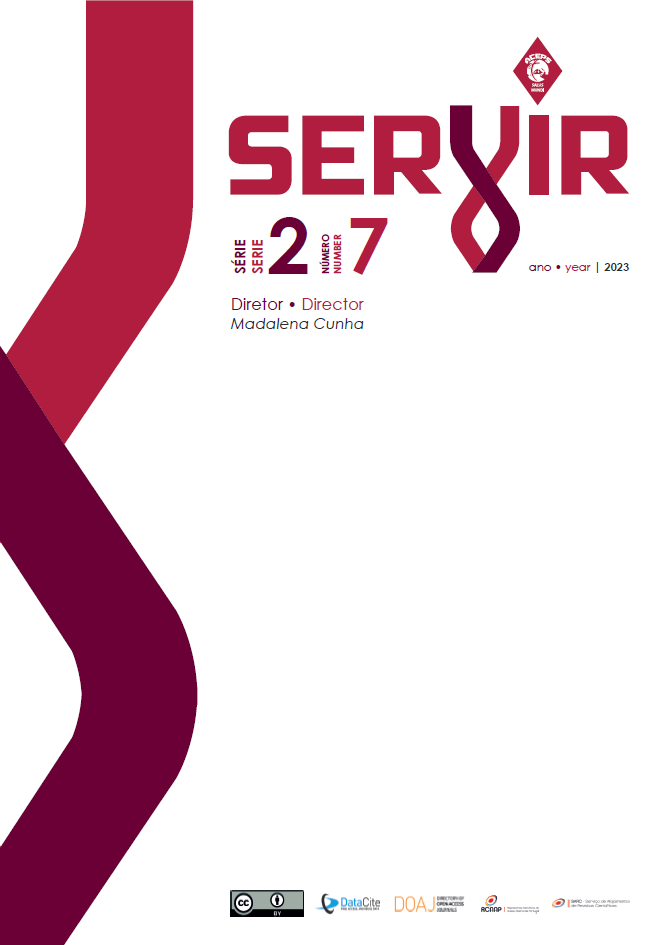The elderly people with 80 or more years in the emergency service
Own’s Evaluation
DOI:
https://doi.org/10.48492/servir0207.31450Keywords:
Elderly Person, Emergency ServiceAbstract
Introduction: The increase in the average life expectancy of the population has been significantly reflected in the accentuated rate of aging and in the increase in the prevalence of chronic diseases, leading to an increase in the influx to the Emergency Services, by the elderly person aged 80 and over.
Objective/s: Identify the reasons for visits to the emergency room by the elderly person with 80 or more years, taking into account their own perspective.
Methods: Observational, descriptive cross-sectional cohort study in a non-probabilistic sample of 53 elderly people aged 80 and over, with a mean age of 88.60 years, most of whom were female (60.38%) who resorted to the Emergency Service of a Hospital Centre in
the North of Portugal and who were sorted according to the Manchester Triage Protocol as non-urgent (green, blue and white). Data collection was carried out using interviews.
Results: The most prevalent reasons that lead elderly people aged 80 and over to the Emergency Service were according to themselves: generalized pain (52.83%), difficulty breathing (26.42%), with an equal number of answers: fever and malaise (20.75%) and falls (15.10%). Of the relevant suggestions for reducing the number of elderly people aged 80 and over going to the Emergency Service, the highlights were the existence of longer hours in health care centres (31.71%), the existence of more doctors in the health care centre (28.57 %) and with the same number of responses, carrying out auxiliary diagnostic tests at Health Care Centres and greater medical availability for open consultations (21.43%).
Conclusion: The identification of the reasons for visits to the Emergency Service experienced by the elderly aged 80 and over brings out the need for greater symptomatic control for the elderly and greater monitoring by Primary Health Care. It is suggested that this study be replicated with a larger sample, due to its reduced number and the scarcity of studies that focus only on the trip of elderly people aged 80 and over to the Emergency Service, since the vast majority of studies existing ones cover ages equal to or greater than 65 years.
Downloads
References
Almeida, A. S., & Gomes, I. D. (2021). Os motivos que levam as pessoas idosas a recorrer frequentemente ao serviço de urgência. Revista Brasileira Em Promoção Da Saúde, 34. https://doi.org/10.5020/18061230.2021.13428
Andrews, H., & Kass, L. (2018). Non urgent use of emergency departments: populations most likely to overestimate illness severity. Internal and Emergency Medicine; 1–8. https://www.ncbi.nlm.nih.gov/pubmed/29380133.
Conselho das Finanças Públicas (2022). Evolução do desempenho do Serviço Nacional de Saúde em 2021. https://www.cfp.pt/uploads/publicacoes_ficheiros/cfp-rel-07-2022.pdf
CRRNEU. (2012). Reavaliação da Rede Nacional de Emergência e Urgência. https://www.anmp.pt/files/dsg/2012/div/ReavaliacaoRedeNacionalEmergenciaUrgancia20120701.pdf
Despacho Ministerial nº 18459/2006 de 12 de setembro, 2006. Diário da República n.º 176/2006, Série II de 2006-09-12. https://files.dre.pt/2s/2006/09/176000000/1861118612.pdf.
Despacho Normativo nº 10319/2014 de 11 de agosto, 2014. Diário da República n.º 153/2014, Série II de 2014-08-11. https://files.diariodarepublica.pt/2s/2014/08/153000000/2067320678.pdf.
Dufour, I., Chouinard, M.-C., Dubuc, N., Beaudin, J., Lafontaine, S., & Hudon, C. (2019). Factors associated with frequent use of emergency-department services in a geriatric population: a systematic review. BMC Geriatrics ; 19(185), 1–9.
Fundação Francisco Manuel dos Santos. (2023). Índice de envelhecimento e outros indicadores de envelhecimento. https://www.pordata.pt/portugal/indice+de+envelhecimento+e+outros+indicadores+de+envelhecimento-526.
Gagnon-Roy, M., Hami, B., Généreux, M., Veillette, N., Sirois, M.-J., Egan, M., & Provencher, V. (2018). Preventing emergency department (ED) visits and hospitalisations of older adults with cognitive impairment compared with the general senior population: what do we know about avoidable incidents? Results from a scoping review. BMJ Open, 8(4), e019908. doi:10.1136/bmjopen-2017-019908
Hoogendijk, E. O., Afilalo, J., Ensrud, K. E., Kowal, P., Onder, G., & Fried, L. P. (2019). Frailty: implications for clinical practice and public health. The Lancet; 394, 1365– 1375. https://doi.org/10.1016/S0140-6736(19)31786-6.
Kraaijvanger, N., Rijpsma, D., Willink, L., Lucassen, P., Leeuwen, H. van, & Edwards, M. (2016). Why patients self refer to the Emergency Department: A qualitative interview study. Journal of Evaluation in Clinical Practice; 23, 593–598. https://onlinelibrary.wiley.com/doi/epdf/10.1111/jep.12680
Kuek, B. J. W., Li, H., Yap, S., Ng, M. X. R., Ng, Y. Y., White, A. E., & Ong, M. E. H. (2018). Characteristics of frequent users of Emergency Medical Services in Singapore. PREHOSPITAL EMERGENCY CARE, 0(0), 1–10.
McCabe, J. J., & Kennelly, S. P. (2015). Acute care of older patients in the emergency department: strategies to improve patient outcomes. Open access emergency medicine: OAEM, 7, 45–54. https://doi.org/10.2147/OAEM.S69974.
Marsden, E., Taylor, A., Wallis, M., Craswell, A., Broadbent, M., Barnett, A., … Glenwright, A. (2017). A structure, process and outcome evaluation of the BMC. Geriatrics, 17(76), 1–8. https://www.ncbi.nlm.nih.gov/pmc/articles/PMC5363028/pdf/12877_2017_Article _462.pdf.
PORDATA. (2022). Estatísticas Sobre Portugal e Europa. Obtido de https://www.pordata.pt/Home.
Schneider, R. H., & Irigaray, T. Q. (2008). O envelhecimento na atualidade: aspectos cronológicos, biológicos, psicológicos e sociais. Estudos de Psicologia (Campinas), 25(4), 585–593. doi:10.1590/s0103-166x2008000400013.
Plano de Atividades e Orçamento do CHTV (2022). https://www.chtv.min-saude.pt/wp-content/uploads/sites/24/2022/10/Plano-Atividades-e-Or%C3%A7amento-2022.pdf.
Sebastião, S.M.F.A. de (2019). Marcadores de risco dos clientes admitidos no serviço de urgência. [Dissertação de Mestrado]. Escola Superior de Saúde de Viseu. URI: http://hdl.handle.net/10400.19/5458
Sebastião, S., & Cunha, M. (30 de dezembro de 2021). O paciente emergente no serviço de urgência. Servir, pp. 66-74. doi: https://doi.org/10.48492/servir0201.25679.
Published
How to Cite
Issue
Section
License
Copyright (c) 2023 Fernando Pina, Fernando Pina, Joana Cardoso, Leonardo Almeida, Letícia Mendes, João Vicente, Luís Rodrigues, Madalena Esteves, Paula Ferreira, Madalena Cunha

This work is licensed under a Creative Commons Attribution 4.0 International License.
In order to promote the free circulation of knowledge, Servir is open access journal. All its content is available and protected under the Creative Commons license (CC BY 4.0).
The journal allows self-archiving in institutional repositories of all versions, which may become immediately available


